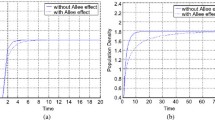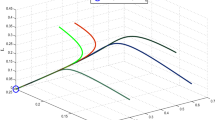Abstract
Local stability seems to imply global stability for population models. To investigate this claim, we formally define apopulation model. This definition seems to include the one-dimensional discrete models now in use. We derive a necessary and sufficient condition for the global stability of our defined class of models. We derive an easily testable sufficient condition for local stability to imply global stability. We also show that if a discrete model is majorized by one of these stable population models, then the discrete model is globally stable. We demonstrate the utility of these theorems by using them to prove that the regions of local and global stability coincide for six models from the literature. We close by arguing that these theorems give a method for demonstrating global stability that is simpler and easier to apply than the usual method of Liapunov functions.
Similar content being viewed by others
Literature
Fisher, M. E., B. S. Goh and T. L. Vincent. 1979. “Some Stability Conditions for Discrete-Time Single Species Models”.Bull. Math. Biol. (In press).
Goh, B. S. 1979.Management and Analysis of Biological Populations. New York: Elsevier.
Hassell, M. P. 1974. “Density Dependence in Single Species Populations.”J. Anim. Ecol.,44, 283–296.
LaSalle, J. P. 1976.The Stability of Dynamical Systems. Philadelphia: SIAM.
May, R. M. 1974. “Biological Populations with Nonoverlapping Generations: Stable Points, Stable Cycles, and Chaos.”Science,186, 645–647.
Moran, P. A. P. 1950. “Some Remarks on Animal Population Dynamics.”Biometrics,6, 250–258.
Pennycuick C. J., R. M. Compton and L. Beckingham. 1968. “A Computer Model for Simulating the Growth of a Population, or of Two Interacting Populations.”J. theor. Biol.,18, 316–329.
Ricker, W. E. 1954. “Stock and Recruitment.”J. Fish. Res. Bd. Can.,11, 559–623.
Smith, J. M. 1968.Mathematical Ideas in Biology. Cambridge University Press.
— 1974.Models in Ecology. Cambridge University Press, Cambridge, U.K.
Utida, S. 1957. “Population Fluctuation, an Experimental and Theoretical Approach.”Cold Spring Harbor Symp. Quant. Biol.,22, 139–151.
Author information
Authors and Affiliations
Rights and permissions
About this article
Cite this article
Cull, P. Global stability of population models. Bltn Mathcal Biology 43, 47–58 (1981). https://doi.org/10.1007/BF02460938
Received:
Revised:
Issue Date:
DOI: https://doi.org/10.1007/BF02460938




